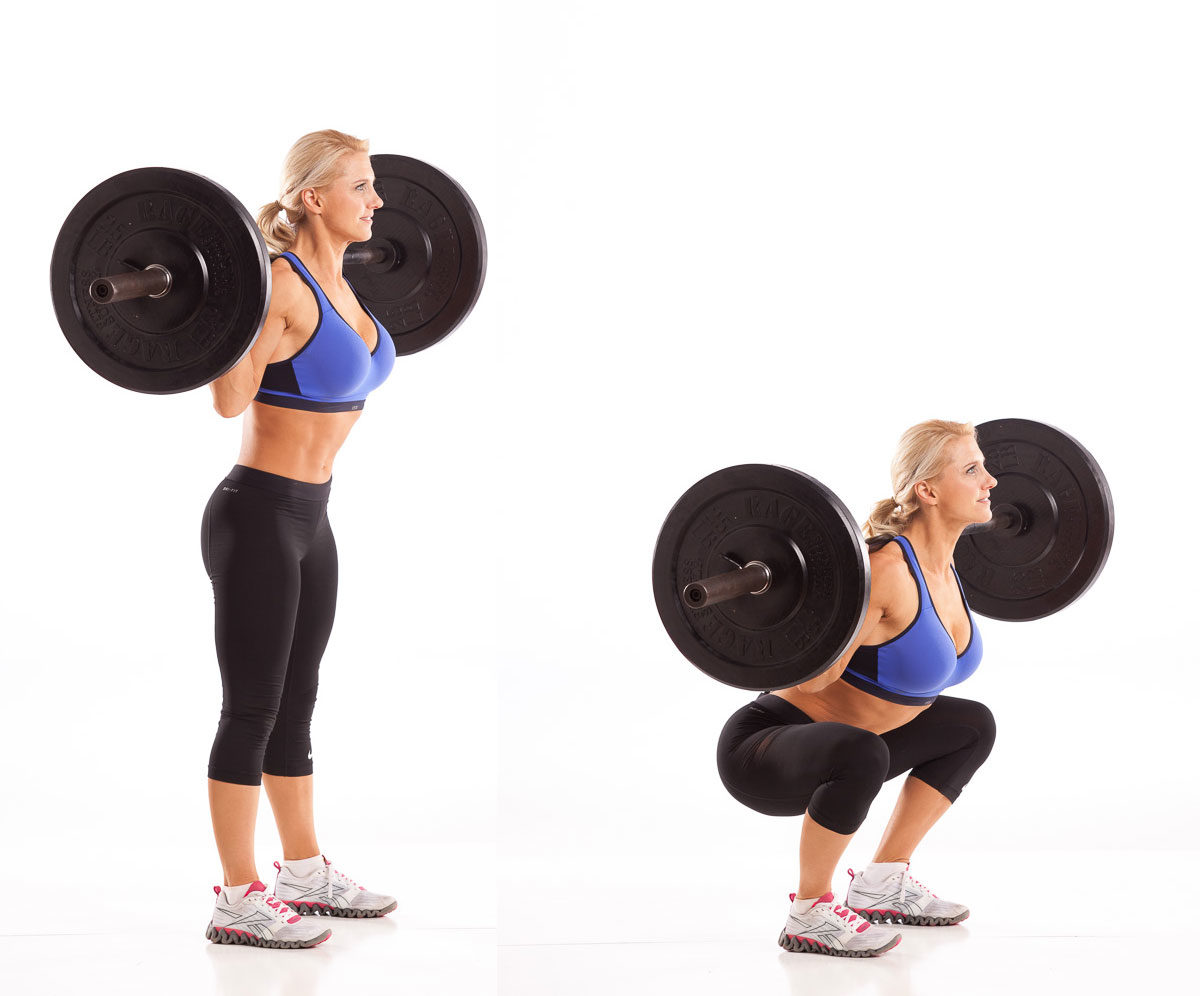How to Barbell Back Squat | Science Backed Exercise Video, Tips & FAQs
There is a good reason why barbell back squats are included by most every physical therapist and personal trainer world-wide. They really are one of the best leg exercises on the planet for women looking to build lean, defined legs. Know for its unparalleled ability to sculpt, strengthen, and transform the female physique, barbell back squats are one of my favorite go-to exercises. And it is not just because they are so effectiveness in building powerful legs and a firm bum. This compound movement also engages the core, back, and shoulders, offering a full-body workout that promotes functional strength and endurance.
If you are a women seeking to elevate your lower body workout, the barbell back squat is about more than mere aesthetics by contributing to improved posture, enhanced athletic performance, and a marked increase in daily energy levels. In this article, I will take you through the mechanics and benefits of this fundamental leg exercise so you can safely incorporate the barbell back squat into your routine with confidence.
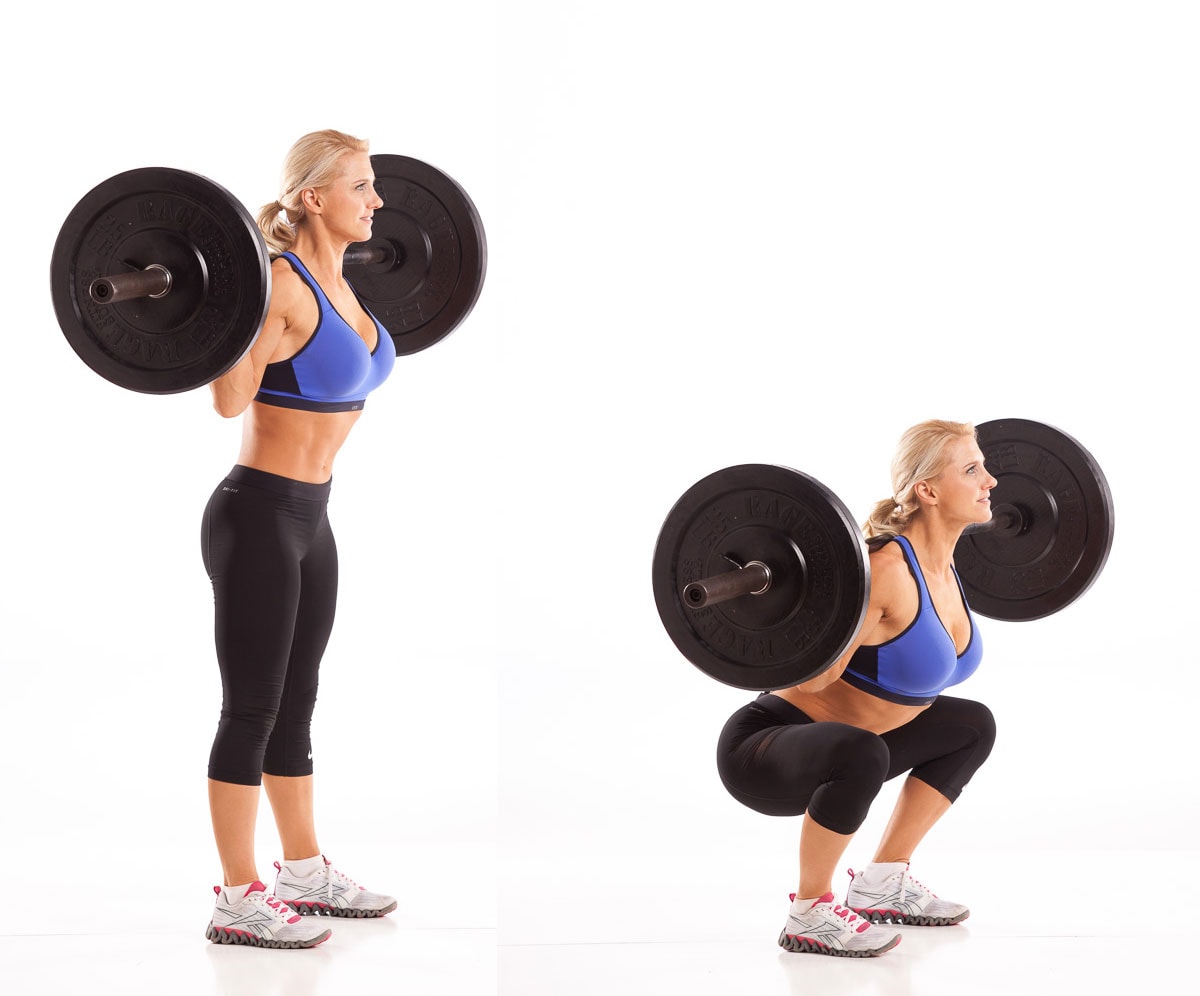
Barbell Back Squat Demonstrated by Julie Lohre, CPT and Women’s Fitness Expert
How to Do A Back Squat Properly:
Safety with big lifts really is paramount as you can get hurt if you are not using proper form. If you have been wondering how to do a back squat properly, let me take you through the movement step by step.
1. Barbell Back Squat Setup
- Rack Height: Adjust the squat rack so that the barbell is at mid-chest level. This allows you to lift the bar out of the rack with your legs rather than pulling it up with your back.
- Bar Position: Approach the bar and position it across your upper back (trapezius muscles) for a high bar squat or a bit lower on your back for a low bar squat. The high bar position is more quad-dominant, while the low bar engages more of the posterior chain (glutes and hamstrings).
- Grip: Place your hands on the bar slightly wider than shoulder-width apart, palms facing forward. Your grip should be firm, and your wrists should be in a neutral position.
- Body Position: Step under the bar, positioning it comfortably across your shoulders. Stand with your feet shoulder-width apart or slightly wider, toes pointing slightly outward.
2. Un-rack the Bar
- Lift the bar out of the rack by straightening your legs, standing up with the weight. Take one or two steps back to clear the rack, and position your feet as you did before, ensuring they are parallel and stable.
3. Squat Down
- Start: Take a deep breath and hold it to brace your core, increasing intra-abdominal pressure for spinal support.
- Movement: Begin by bending at the hips and knees simultaneously, lowering your body as if sitting back into a chair. Keep your back straight and chest up to maintain a neutral spine.
- Depth: Aim to lower yourself until your hip joint is below your knees (hip crease below the top of the knee), which is considered full depth, if mobility allows. Your knees should track over your toes without collapsing inward.
4. Ascend
- Drive Up: As you ascend from the Barbell Back Squat, push through your heels and the balls of your feet to stand back up, extending your hips and knees simultaneously. Exhale as you ascend.
- Path: Keep the bar over the center of your feet and your body balanced. The movement should be smooth and controlled, with your back straight and core engaged throughout.
5. Rerack the Bar
- Once you’ve completed your set, step forward carefully and place the bar back into the rack. Ensure the bar is securely positioned before letting go.
Safety Tips
- Always use a spotter or safety bars when squatting with heavy weights.
- Warm up thoroughly before attempting your working sets.
- Begin with a weight that allows you to maintain form and gradually increase as you become more comfortable and stronger.
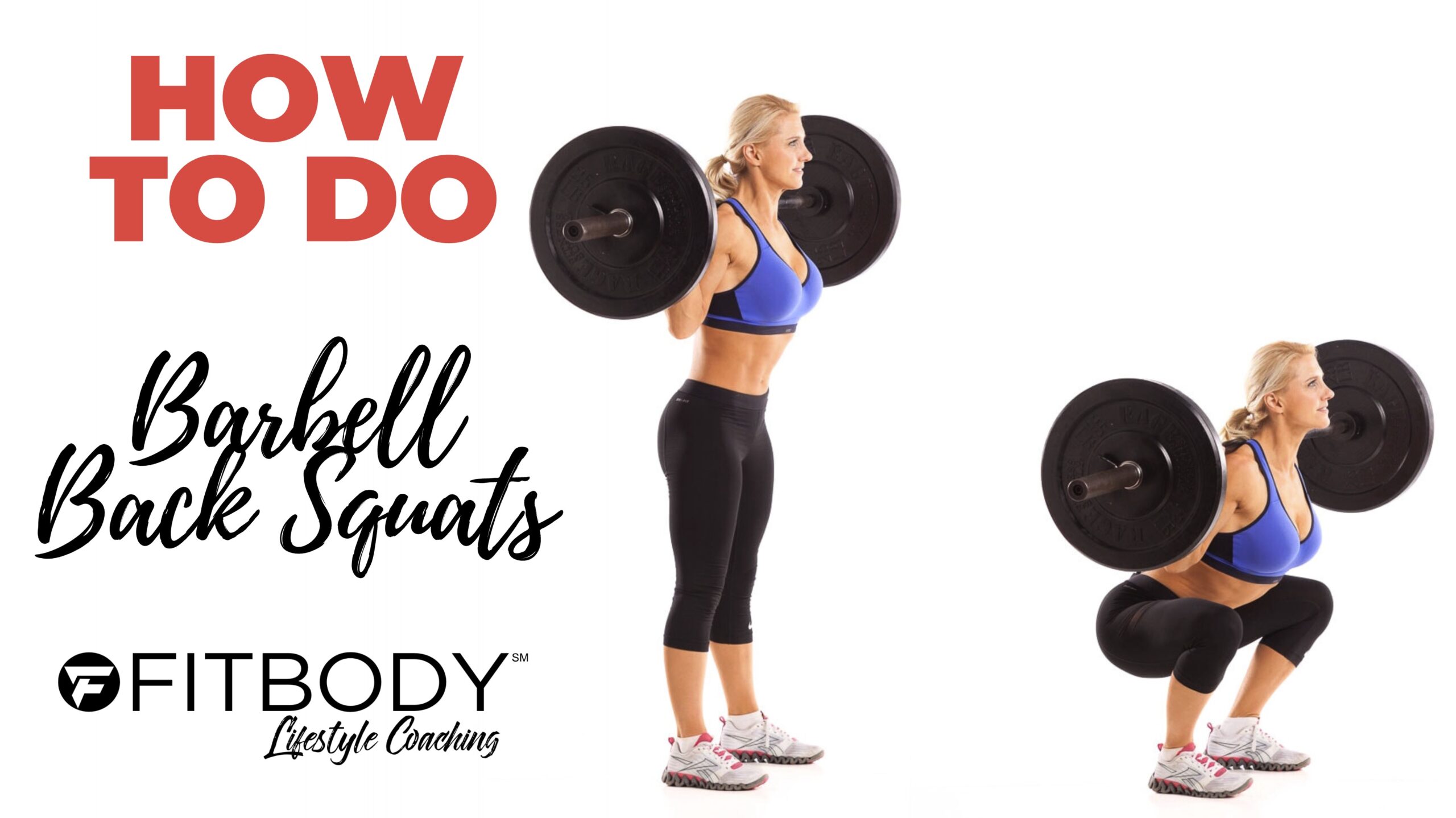
FITBODY Barbell Back Squat Coaching Tips
To maximize its effectiveness and minimize the risk of injury, here are my top five coaching tips to enhance your barbell back squat:
- Proper Bar Placement: There are two common placements for the barbell during a back squat: high bar and low bar. High bar squats rest the bar on the traps, which is better for quad dominance. Low bar squats position the bar slightly lower on the upper back, engaging the glutes and hamstrings more. Choose the position that aligns with your goals and feels the most comfortable, but ensure the bar is secure and stable.
- Foot Positioning and Stance: Your feet should be slightly wider than shoulder-width apart, with toes pointing slightly outward. This stance provides stability and allows for deeper squatting while ensuring the knees track over the toes, reducing the risk of injury. The exact width can vary based on your mobility and anatomy, so find the stance that allows you to squat deepest with comfort.
- Depth and Form: Aim to squat down until your hips are at least parallel to your knees (or lower if your mobility allows), ensuring your knees stay aligned with your toes and do not cave inward. This depth is crucial for fully engaging the quads and glutes. Keep your chest up and back straight throughout the exercise to maintain a neutral spine.
- Driving Through the Heels: When rising from the bottom of the barbell back squat, focus on driving through your heels and the outer edge of your foot. This technique helps to more effectively engage your glutes and hamstrings, providing a powerful lift while also protecting your knees from undue stress.
- Breath Control and Core Engagement: Proper breathing technique and core engagement are vital for stability and power in the squat. Inhale as you lower down, engaging your core to keep your torso stable. Exhale forcefully through the sticking point as you rise back up. This controlled breathing not only helps maintain good form but also braces the core to support your lower back.
Implementing these tips can greatly improve your squat performance, leading to better strength and muscle gains while reducing the risk of injury. Always start with a weight that allows you to maintain proper form and gradually increase as you become more comfortable with the exercise.
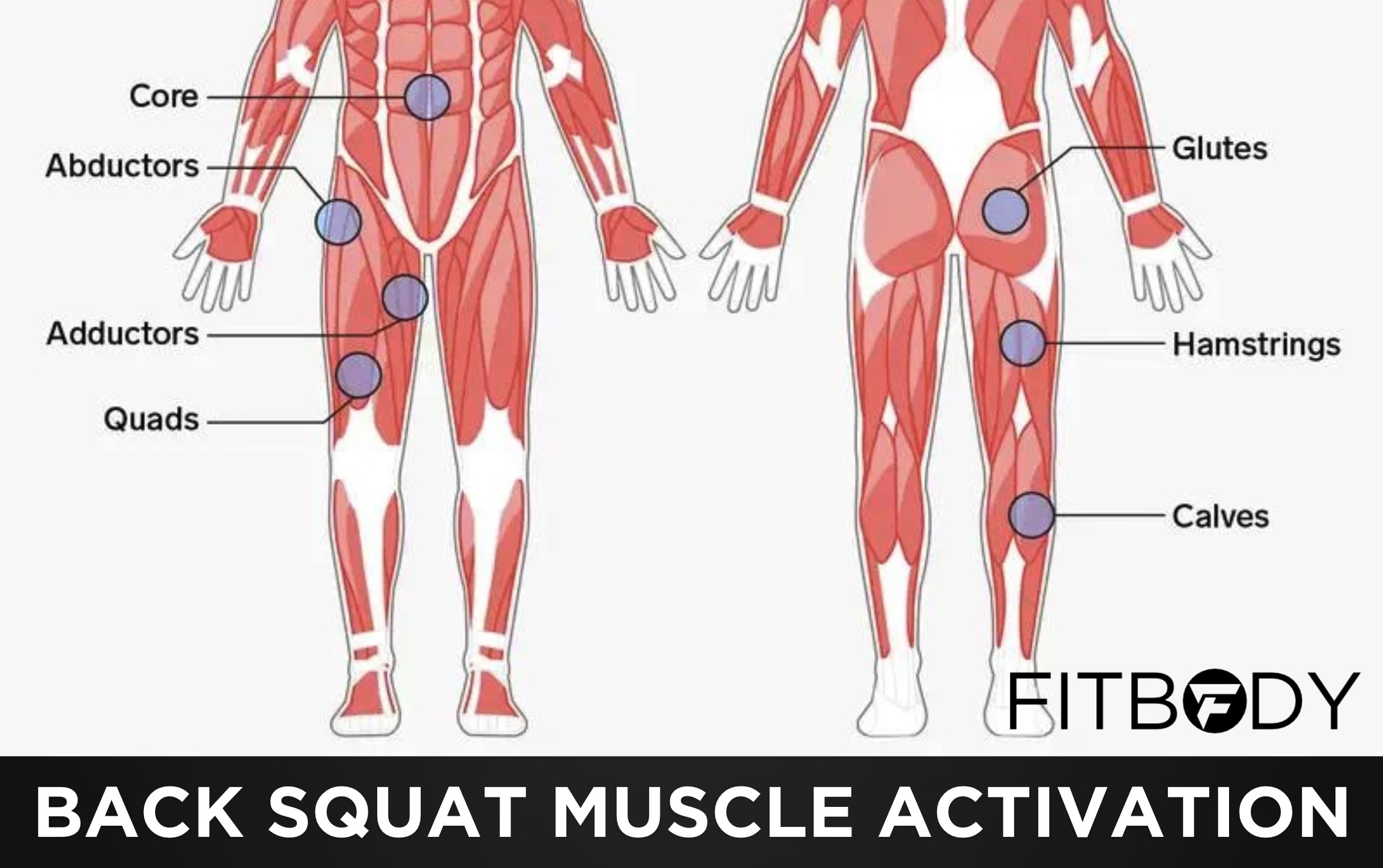
What Does The Barbell Back Squats Work?
The barbell back squat is a comprehensive, compound exercise that targets multiple muscle groups across the body, with a particular focus on the lower body. Here’s a breakdown of the primary muscles worked during a barbell back squat:
- Quadriceps: The front thigh muscles are the main movers during the upward phase of the squat. They are responsible for knee extension.
- Gluteus Maximus: These are the muscles in your buttocks and are heavily engaged during the squat to extend the hip, especially as you rise from the bottom position.
- Adductor Magnus: Located in the inner thigh, this muscle works alongside the glutes and quads to stabilize the legs and assist in hip extension.
- Hamstrings: The muscles on the back of the thigh work with the glutes to extend the hip. They play a more secondary role in the squat but are still engaged throughout the movement.
- Erector Spinae: These are the muscles that run along your spine. They work isometrically (without changing length) during the squat to keep your spine in a neutral position and support the weight of the barbell.
- Core Muscles (Abdominals and Obliques): Your core muscles are engaged throughout the squat to stabilize the body and maintain posture. This includes the rectus abdominis, the obliques, and the deeper core muscles.
- Calves (Gastrocnemius and Soleus): Though not the primary focus of the squat, the calf muscles assist in stabilizing the ankle joint and contribute to the control of the movement.
Secondary muscles involved include the hip flexors, the muscles around the shoulder that stabilize the barbell, and the forearm muscles which grip the bar. Due to the compound nature of the exercise, squats also engage connective tissue (ligamens and tendons) throughout the body, contributing to overall joint health and stability.
Back Squat Frequently Asked Questions
So, Why Are Squats good for your back?
Squats, particularly when performed with proper form, can confer substantial benefits to spinal health and back strength due to their multifaceted engagement of the musculoskeletal and nervous systems. First, they stimulate the erector spinae, the muscle group running parallel along the spine, which fortifies the back against injuries and improves posture by enhancing spinal stability and alignment.
Additionally, squats encourage the activation of the core muscles, including the transversus abdominis and multifidus, which function synergistically to support the lumbar spine, reducing the risk of lower back pain and degenerative spinal conditions. This balanced muscular engagement increases the intra-abdominal pressure, effectively creating a ‘natural corset’ that supports the lumbar region, mitigating shear and compressive forces on spinal discs and ligaments.
Furthermore, by improving musculoskeletal coordination and proprioception, squats enhance the body’s ability to perform movements with efficiency and safety, thereby preventing strains that could lead to back injuries. From a biomechanical perspective, regular squatting under appropriate loads promotes the remodeling and strengthening of the connective tissue, bones, and joints involved in the exercise, contributing to a more resilient back and overall musculoskeletal system.
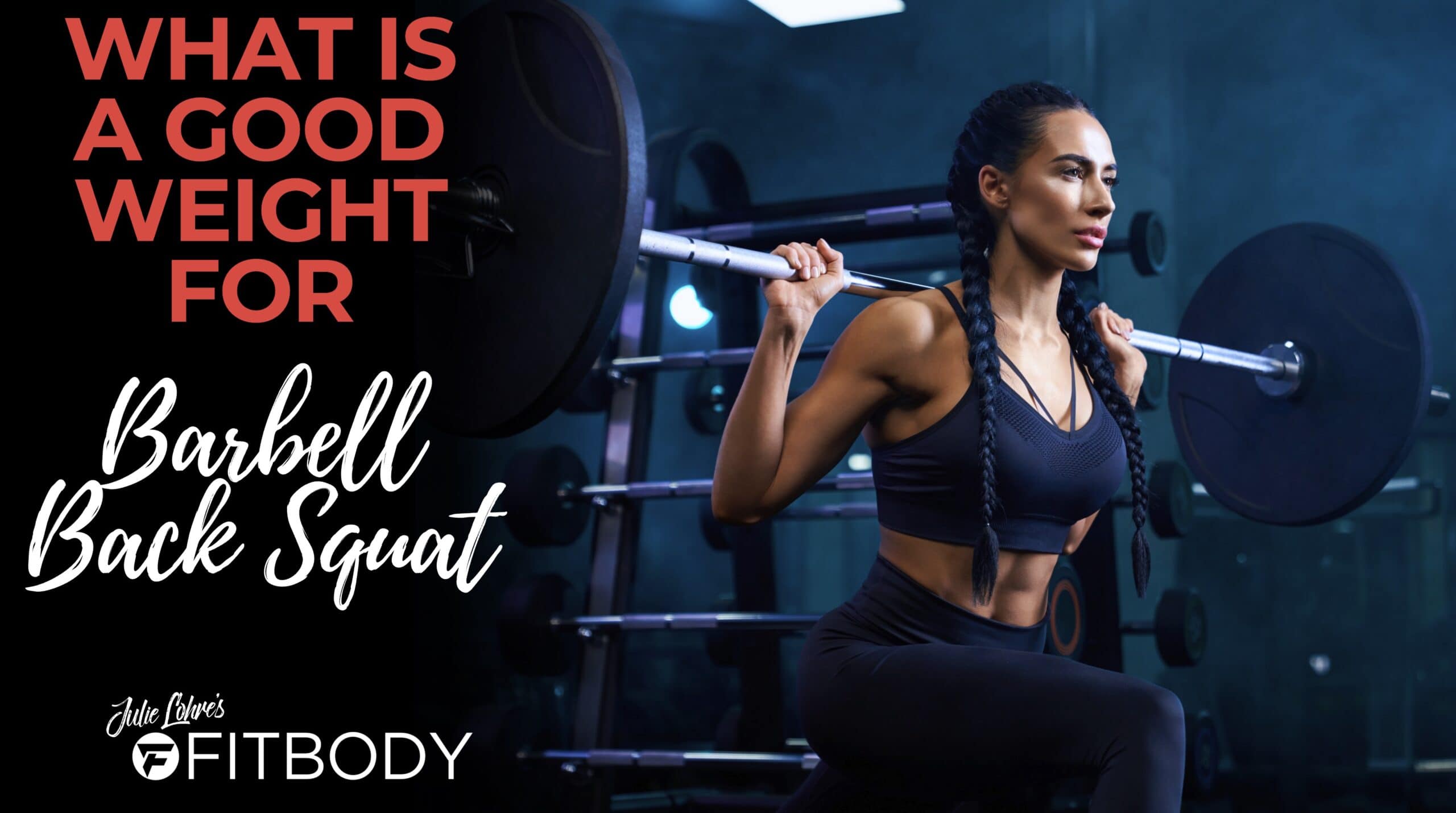
What is a good weight for back squat?
The “ideal” weight a woman should aim for when doing a barbell back squat varies significantly depending on several individual factors, such as experience with strength training, current strength levels, body weight, goals, and overall health. There isn’t a one-size-fits-all number, but here are some considerations that can help guide goal setting:
Back Squat Beginners
- Start with the bar alone (45 lbs or 20 kg) to focus on technique. In fact, if that feels too heavy, choose a 35 pound barbell, also known as a woman’s barbell or even utilize a PVC pipe to begin working form.
- Gradually add weight in small increments (5-10 lbs or 2.5-5 kg) as form allows.
Back Squat Intermediate – Advanced Lifters
- For women that are striving to find what is a good weight for back squat and consider themselves to be intermediate – advanced lifters, I suggest aiming for a squat that is approximately equal to her body weight and advancing up to 1.5 times her body weight over time.
Setting Realistic Goals
- Strength Standards: Resources like Symmetric Strength provide benchmarks based on body weight and experience level, offering a framework to understand where one might fall on a spectrum from novice to elite.
- Personal Goals: Some may aim for specific weights due to competitive lifting goals, while others might focus on improving overall strength, fitness, and health without a specific weight target.
Health and Safety First
- Form Over Weight: I cannot emphasize enough the importance of proper form when lifting heavier weights to prevent injuries. I would much rather women lift moderate weights safely than max out barbell back squats by using poor or compromised form.
- Progress Gradually: Increase weights gradually to ensure your body adapts properly.
- Listen to Your Body: Pay attention to how your body responds to training, and adjust your goals accordingly.
Ultimately, the “ideal” weight a women should lift for barbell back squats should align with your fitness goals, progress, and what feels challenging yet achievable for you, ensuring safety and enjoyment in your training journey.
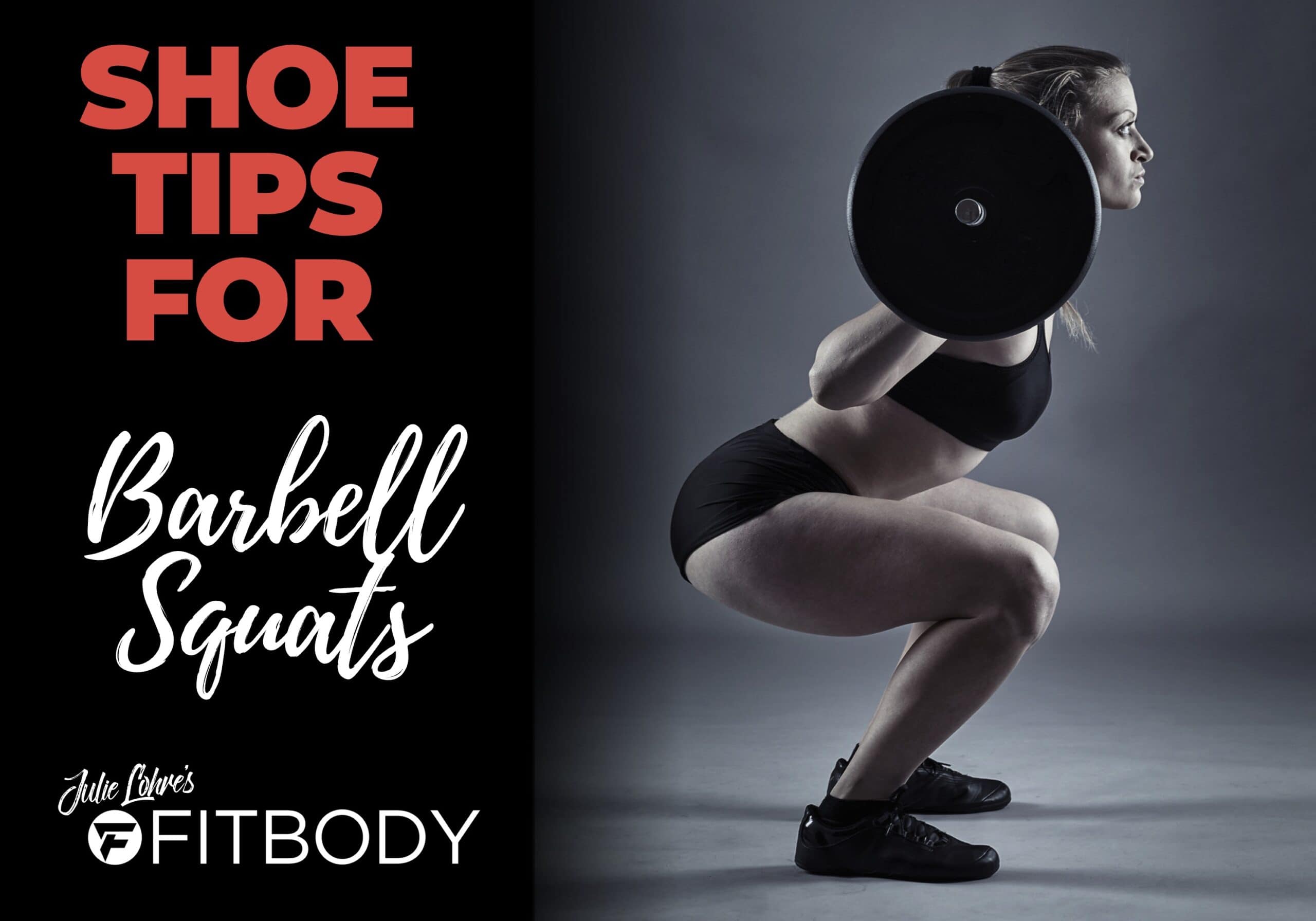
What are the best shoes for squatting?
As a women’s fitness expert, I am asked frequently about footwear for big lifts like barbell back squats. The best shoes for squatting are those that provide a stable, flat, or minimally cushioned base, enhancing your ability to maintain proper form and maximize force production from the ground up. The ideal choice can vary based on personal preference, squatting style, and individual biomechanics. Here’s a breakdown of the types of shoes I often recommend for squatting and their benefits:
Weightlifting Shoes
- Features: These have a hard, non-compressible sole and a raised heel (usually about 0.5 to 1 inch). The raised heel helps in maintaining an upright torso and allows for deeper squat depth by improving ankle mobility.
- Best For: Athletes who perform Olympic lifts, those with limited ankle mobility, or individuals who prefer high bar or front squats.
Minimalist Shoes
- Features: Minimalist shoes offer a thin, flat sole that allows you to feel the ground beneath your feet, promoting a more natural foot position and better force transfer.
- Best For: Lifters who prefer a more “barefoot” feel during squats, emphasizing balance and a natural stance.
Flat Soled Shoes
- Features: Shoes with flat soles, such as Converse Chuck Taylors, are popular among powerlifters. They provide stability and a solid connection to the floor, crucial for heavy lifting.
- Best For: General squatting and powerlifting, especially for those performing low bar squats.
Cross-Trainers **Julie’s Personal Favorite Shoe Type for Squats
- Features: These provide a versatile option with more cushion than weightlifting or minimalist shoes but less than typical running shoes. They offer a balance between stability and flexibility.
- Best For: Individuals looking for a good all-around gym shoe that is adequate for squatting as well as other exercises. Since I include back squats frequently within full workouts, I tend to stick with cross-trainers that can go from lift to lift with stability.
Considerations When Choosing Squatting Shoes:
- Mobility: Your ankle and hip mobility can influence the type of shoe that’s best for you. Limited mobility might be aided by a shoe with a raised heel.
- Squatting Style: High bar, low bar, and front squats may benefit from different types of footwear due to variations in biomechanics and depth.
- Personal Comfort: Ultimately, the best shoe is one that feels comfortable and stable, allowing you to squat with confidence and proper form.
Choosing the right shoes is a crucial element in optimizing your squat performance, enhancing safety, and achieving your lifting goals.
Do Barbell back squats grow glutes?
Yes, barbell back squats can significantly contribute to glute growth due to the biomechanical and muscular demands of the exercise. During the squat, the gluteus maximus, one of the largest and most powerful muscles in the body, is heavily engaged, especially during the ascent phase when rising from the bottom position. This phase requires the extension of the hip joint, a primary function of the gluteus maximus, which is activated to drive the body upward against the load. The muscle fibers in the glutes are subjected to both stretch and contraction under significant tension, which is a key stimulus for hypertrophy (muscle growth).
Moreover, the depth of the squat influences glute activation. Research indicates that squatting to parallel or below (where the hip joint goes lower than the knees) can increase the recruitment of the gluteal muscles. The increased range of motion demands greater muscle elongation and contraction, thereby enhancing the stimulus for growth. Additionally, the stabilization required throughout the movement engages the gluteus medius and minimus, supporting overall glute development. Incorporating variations in stance width and foot placement can further target the glutes, making the barbell back squat a versatile exercise for gluteal hypertrophy. Proper form, progressive overload, and adequate recovery are essential to maximize the growth potential from squats.
What is the difference between a Barbell Front Squat & Barbell Back Squat?
All squats will help us get stronger, jump higher and run faster while shaping your legs and butt. I wrote an extensive article outlining the difference between Front Squat versus Back Squat – and how to determine might be best for your goals. Read more on squat variations here in this article.
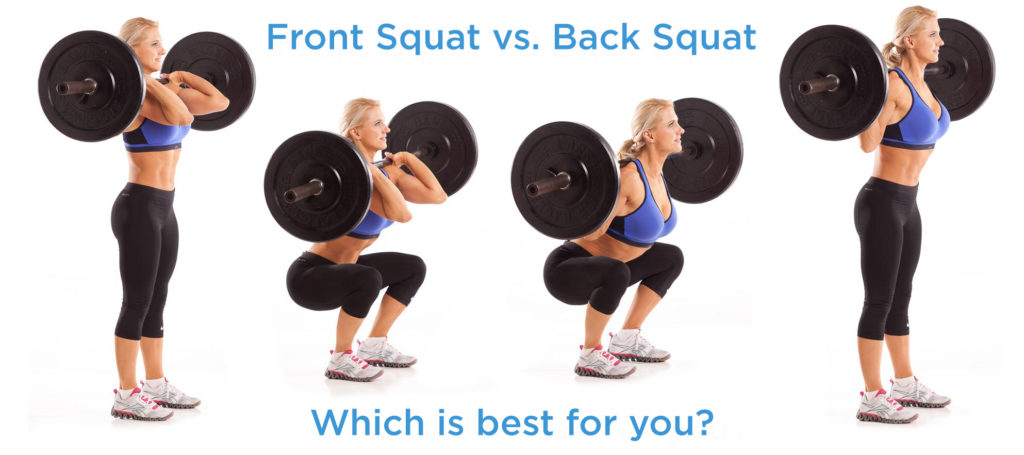
Scientific Research
The following scientific research has been references in this article:
- Myer, Gregory D., et al. “The Back Squat.” Strength and Conditioning Journal, vol. 36, no. 6, Dec. 2014, pp. 4–27, www.ncbi.nlm.nih.gov/pmc/articles/PMC4262933/, https://doi.org/10.1519/ssc.0000000000000103.
- Witmer, Chad A., et al. “The Acute Effects of Back Squats on Vertical Jump Performance in Men and Women.” Journal of Sports Science & Medicine, vol. 9, no. 2, 1 June 2010, pp. 206–213, www.ncbi.nlm.nih.gov/pmc/articles/PMC3761744/.
- Peeni, Manu. The Effects of the Front Squat and Back Squat on Vertical Jump and Lower Body Power Index of Division 1 Male Volleyball Players. https://scholarsarchive.byu.edu/cgi/viewcontent.cgi?article=1929&context=etd
- Hartmann, Hagen, et al. “Influence of Squatting Depth on Jumping Performance.” Journal of Strength and Conditioning Research, vol. 26, no. 12, Dec. 2012, pp. 3243–3261, https://doi.org/10.1519/jsc.0b013e31824ede62.

